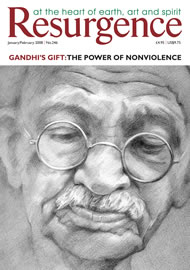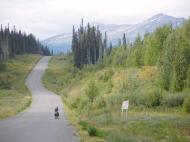I CYCLED OUT of El Paso on 19th June, last summer, at high noon. It was like riding into an oven. I was aiming for Alaska though at that point, veering erratically with the unaccustomed weight of the panniers, I wasn’t convinced that I’d make it beyond the hotel car park.
The trip was partly a personal challenge, partly an investigation into climate change. We hear so much about North America that is negative. Are there any good news stories? And what do ‘ordinary’ people think about climate change in the most oil-intensive country on Earth? My aim was to do the ride and the research – and then find a way of using the story to communicate climate change issues back in the UK.
On a bike journey there is plenty of time to think. One question that constantly recurred as I pedalled slowly through American landscapes and culture was can we make our current lifestyles climate-friendly through advances in technology, or do we need more profound changes in our values and lifestyles themselves? Watching an immense Recreational Vehicle towing a Hummer pull out of a gas station and later, after days of high, wild camping, descending after the climb to Independence Pass into the shock of Aspen – monument to consumerism, excess wealth and status based on possessions – I realised that in fact my own position had clarified. I wrote in my journal:
“This trip is making me more radical. After Aspen I think I reached the view that we simply shouldn’t be allowed to use our resources and expend energy as much as we like, for any purpose we like, limited only by our own wealth. More and more I’m coming to the view that resource consumption should be rationed and that part of the problem is the way we prioritise our freedom of choice as consumers over the protection of the Earth.”
MY DAYS FELL into a routine. Eat, tent down, cycle, eat, cycle, eat, tent up, sleep. Very simple, deeply satisfying. And such a relief to be away from the daily tyranny of emails, computers and phone calls. Deeply satisfying, too, to feel my body getting stronger, watch it change shape and turn brown.
Travelling by bike you are really in the landscape. You smell, hear and feel it as you inch slowly over the atlas, open to all weather, your progress and state of mind constantly changing with wind, rain and sunshine. At an average of 10mph the landscapes unfold slowly enough to feel, but fast enough to witness a whole mountain range.
I followed the Rockies through New Mexico, where the Continental Divide was a barely discernible rise through miles of hot desert scrub, into Colorado, where huge meadows run up to forests sloping up to big, big, hills. Here the Continental Divide rises to 12,000 feet, and as your own body strains slowly upwards you can almost feel the force of the Rockies buckling up into the huge blue sky 175 million years ago. Wolf Creek Pass took five hours of solid slog (though I was cheered by a sign at the top that told me it used to take Model T Fords two days), and Trail Ridge Road, the highest paved road pass in the world, took me all day, the majority in the rain-equivalent of a white-out followed by a twenty-five-mile non-stop cold, wet descent. A friend said later how ironic it would be to get hypothermia and frostbite on a global warming trip. Very funny.
MY PARTNER JOINED me for the second half of the trip and, crossing the Canadian border, we were overwhelmed with the sudden increase in flowers and insects. Clouds of butterflies danced alongside and cycling on the hard shoulder became impossible without crunching over crickets. We found out later that the US sprays its roadside verges and Canada doesn’t. The difference was extraordinary – but you’d probably have to be on a bike to notice it. We saw larger wildlife too, of course. Long-legged moose sauntering across the road, elk, wolves, buffalo, black bear, and once, while I was alone, a lynx walked out of the woods and stood quite still for several
seconds, just in front of me.
Given the nature of the trip and the impact of climate change on mountain species in particular, these encounters were very poignant. They strengthened our resolve to campaign for a more sustainable future. Less consumption and a different model of success from that embedded in the worst excesses of the American dream have to be part of this. This is not just about giving things up. When you are sitting by the banks of the Cinnamon River watching beavers, the absence of shopping malls is not a deficit. Al Gore writes of the deep loss we experience through disconnection from other living things, a loss we try to compensate for through consumption. But we don’t need to be cycling the Alaskan Highway to encounter the vividness and vibrancy of life – we just need time to be still and let it in, wherever we are. Travelling more slowly in life allows us to reconnect with other living things. This will surely be key as we rebuild our understanding of quality of life in relation to quality of experience rather than quantity of possessions.
We cycled into Anchorage on the 11th September. The 4,553-mile trip took three months. Two months of cycling at 75 miles a day, and one month for meeting people and rest days. The longer we cycled, the more opportunities arose, causing many dilemmas. Do we detour, follow that lead, hang out by that lake, watch those bears, meet those interesting people? Or do we stay focused on getting to Anchorage? I discovered I was still cursed with a fair amount of goal-focused ‘fast travel’ mentality, and we ended the journey with a run of 90-mile days and a burst of ‘get there or bust’ energy. As we cycled past moose on the main road into town we were both elated to have made it. But if I did it again, I’d do it much, much more slowly.
The Carbon Cycle journey was made possible by a Winston Churchill Travelling Fellowship. For information about The Carbon Cycle slide show: [email protected]








